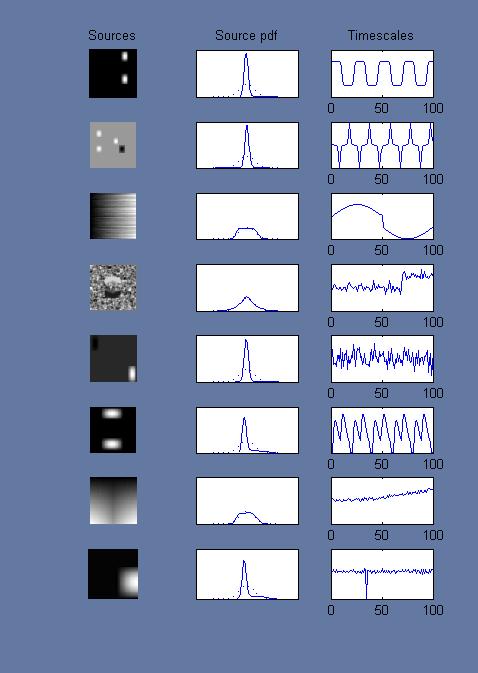Simulating fMRI-like sources
For brain imaging data, there is no a priori knowledge about the ground truth of the underlying components and their modulation profiles across subjects. Hence, in order to test the performance of separation algorithms, we generate a simulated fMRI-like set of components and mix them with a set of time courses to obtain a simulated fMRI-like dataset.FMRI source properties:
FMRI sources can be classified into sources of interest and artifacts. The sources of interest include task-related, transiently task-related, and function-related sources. These sources are typically super-gaussian in nature because of localization of brain functionality. A task-related source (component) closely matches the experimental paradigm. A transiently task-related time course, on the other hand, is similar to a task-related time course but with an activation that may be pronounced during the beginning of each task cycle and may fade out or change as time progresses. Functional sources are those activated areas which are related to a particular functional area of the brain and the time course for these may not exhibit a particular pattern.
The class of uninteresting sources or artifacts include motion related sources due to head movement, respiration, and cardiac pulsation. The time course for head motion may vary slowly with sudden transient fluctuations. The time courses of the respiratory and cardiac pulsation components may appear to be random fluctuations. Scanner drift is another artifact and is characterized by a slowly rising time course. The activation areas due to artifacts are usually spread over a wider area and are sub-gaussian in nature.
Using this basic knowledge of the statistical characteristics of the underlying sources, we simulate fMRI-like source images and mix them with the selected time courses to obtain a set of mixtures. The sources in the figure below includes a representative set from both types of sources, those that are of interest and those that are due to artifacts.
| Simulated fMRI-like sources: |
 |
| Gaussian pdf is shown with dotted line for reference |
The set of sources shown above consists of five highly super-gaussian sources, a gaussian source and two sub-gaussian source and the time courses represent sources that are task-related (S1), transiently task-related (S2, S6) and artifact-related (S3, S4, S5, S7, and S8). Each simulated source is a 60 x 60 image with a 100-point time course. To form the fMRI mixture, first the image data is reshaped into vectors by concatenating columns of the image matrix. The source matrix is multiplied by the time course matrix to obtain a mixture that simulates 100 scans of a single slice of fMRI data.
Publications in which simulated fMRI-like sources have been utilized:
- V. D. Calhoun, T. Adali, G. D. Pearlson, "Independent component analysis applied to fMRI data: A generative model for validating results," VLSI Signal Processing Systems for Signal, Image, and Video Technology, Double Special Issue: Biomedical and Communications Applications of Neural Networks, vol. 37, no. 2/3, pp. 281-291, June/July 2004.
- N. Correa, Y.-O. Li, T. Adali, and V. Calhoun, "Comparison of blind source separation algorithms for fMRI using a new Matlab toolbox: GIFT," in Proc. IEEE Int. Conf. Acoust., Speech, Signal Processing (ICASSP), Philadelphia, PA, vol. 5, pp. 401-403, March 2005.
- Y.-O. Li, T. Adali, and V. D. Calhoun, "Estimating the number of independent components for fMRI data ," Human Brain Mapping, vol. 28, pp. 1251-66, 2007.
- W. Xiong, Y.-O. Li, H. Li, T. Adali, and V. D. Calhoun, "On ICA of complex-valued fMRI: Advantages and order selection," in Proc. IEEE Int. Conf. Acoust., Speech, Signal Processing (ICASSP), Las Vegas, Nevada, April 2008.
- N. Correa, Y.-O. Li, T. Adali, and V. Calhoun, ""Examining associations between fMRI and EEG data using canonical correlation analysis," in Proc. IEEE Int. Symp. Biomedical Imaging, Paris, France, May 2008 .
Resources:
-
Simulated fMRI dataset: Matlab code
